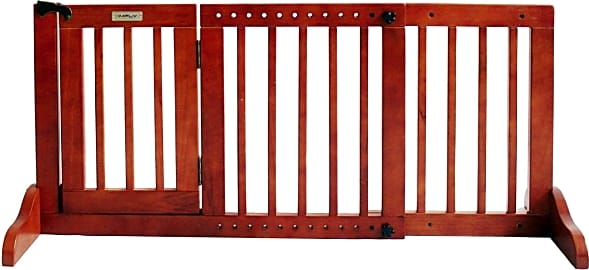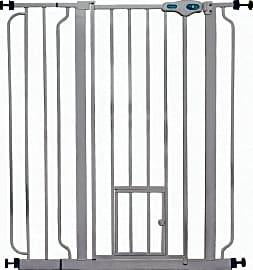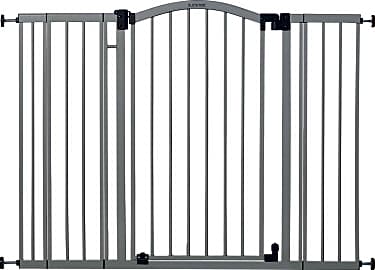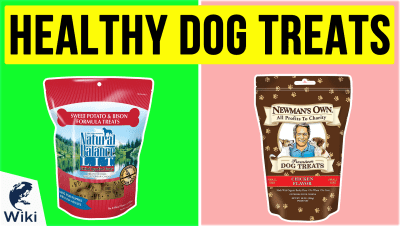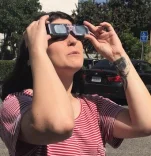The 10 Best Dog Gates

This wiki has been updated 40 times since it was first published in July of 2015. Dogs make wonderful companions and additions to any family that appreciates them. But if a four-legged friend is prone to mischief and curiosity, then one of these pet gates will keep it out of unsafe areas or from sneaking into that bag of kibble. We've included freestanding and permanent options with multiple configurable panels that fit in most doorways, hallways, and on staircases. When users buy our independently chosen editorial recommendations, we may earn commissions to help fund the Wiki.
Editor's Notes
February 14, 2020:
There are myriad reasons people need pet gates, but thankfully, only a few criteria to consider when choosing one. We ensured this list had options for large, strong-willed breeds and small, scrappy ones, plus households with cats. That being said, dogs are smart and very capable -- if your pet has the drive to get around your gate, it likely will. Dogs require a healthy dose of exercise and correction training to help ensure they stay where you want them, gate or not.
Today we said goodbye to the Welland Freestanding and Crown Pet Products Tall due to multiple confirmed complaints regarding their inefficacy and quality. We also removed the Majestic Pet Universal, despite its elegant, high-end construction, because it's narrow wire detailing can present a hazard for small paws and hands. With these new vacancies, we brought on the Cardinal Stairway Special, a versatile model that's easy on walls and thoughtfully designed, the Carlson Lil' Tuffy, an extremely low-maintenance budget pick that is nevertheless durable and strong, and the Cumbor Walk-Thru, a great mid-tier option for pet owners who need something sturdy and tough at a reasonable price.
Remember to always provide fresh drinking water for your dog when he's confined, and a comfy bed and a few toys couldn't hurt, either. Giving your pooch a few comforting items will help reinforce that he isn't being separated as a punishment, rather, that you are giving him his own space.
Special Honors
Fusion Gates Chevron Those who don't want to sacrifice style for function will appreciate the Fusion Gate Chevron. This high-end, dual-mounted pressure gate is engineered for safety and built to strict ASTM standards. It fits entryways from 36 to 52 inches, stands 36 inches tall, and sports a patented, interchangeable art screen made from scratch-resistant polycarbonate. It opens in both directions via a one-finger finial latch and has an automatic closure. fusiongates.com
Tucker Murphy Brandon Gate-N-Crate The stylish Gate-N-Crate is a durable, nontoxic model made entirely from hardwood that's kiln-dried with a natural walnut stain. It's a freestanding option with integrated handles and strong legs for support and stability that can be folded and stowed away when not in use. Pin hinges allow both side panels to rotate almost 360 degrees for endless configurations to fit any space. wayfair.com
What Do I Need to Consider Before Buying a Dog Gate?
Latched doors are a tremendous asset if you plan on leaving the dog gate in place at all times.
The first thing you'll want to consider prior to purchasing a dog gate is the approximate size of your dog. Different gates are designed to accommodate different canines. Your dog may be able to leap over its gate or knock the frame off its moorings, assuming the gate is too flimsy or small.
Next, you'll want to give some thought to the space in which you plan to put the gate. Make sure that any gate you're looking at is wide enough to bridge that area. If you plan on using the gate in multiple spaces (or multiple houses), you'll need one that is adjustable so you can pare it down or set it long. If you plan on transporting a dog gate, you'll need a model that is relatively lightweight (five to 25 pounds) and collapsible enough to fit safely in your car.
Ideally, you'll want a dog gate to be equipped with rails, as opposed to a flat surface. Rails allow the dog a windowed view, which discourages the dog from feeling boxed in, or otherwise punished. Additionally, rails are effective at discouraging a dog from scratching or leaning its weight across the top of a gate. Both of these behaviors could result in a gate getting bent into a state of disrepair.
Certain dog gates have been designed with a latched door fashioned into the grates. This door is meant to allow the dog - or a co-habitiating cat - to enter or exit the gate at will. Latched doors are a tremendous asset if you plan on leaving the dog gate in place at all times. Instead of having to remove the gate, you can simply unlock the door.
How to Get Your Dog to Embrace Its New Gate
Dogs love to be with their owners, and they also love to have free run of the house. That being the case, it's easy to understand why a dog might feel confined upon being placed behind a gate. The best way to avoid this is by letting a dog know that he is not being chastised and that the area behind a gate represents a place where he can have as much fun as he wants.
Think of the area behind that gate as being the dog's personal home.
Think of the area behind that gate as being the dog's personal home. If your dog has a bed it should be inside this area, along with a water bowl, a favorite blanket, and at least a few of the dog's toys. If there are any nearby windows, make sure that those windows are locked, and there is at least some sunlight shining through.
The first few times you place a dog behind his new gate, be sure to reward him with a treat so he understands that he has done nothing wrong. If the dog is reluctant, you can use a treat beforehand to lure him into the required area. If the dog behaves obediently (i.e., no acting out or relieving himself) while behind the gate, that could be cause for a reward, as well.
Some people prefer to keep a dog gate up at all times. This may be convenient, but it also means that your dog is regularly separated from his bed and his toys. If possible, you'll want to remove the gate whenever you're at home so the dog doesn't attach any type of stigma to the fenced-off area. Over time, the dog should accept that once the gate goes up, you are simply trusting him to be on his own.
A Brief History of The Dog Gate
Modern-day dog gates are an outgrowth of two inventions: the pet door and the baby gate. The pet door, which evolved from being a small hole to an actual flap, has been around for centuries. The first patent for a baby gate was awarded to a Massachusetts inventor named Charles McDonald in 1906. McDonald's gate consisted of two pegboards, both of which were connected by hinges. McDonald's gate was meant to be placed across a stairwell, thereby prohibiting any toddlers from taking a dangerous fall.
These gates are also used to keep a pet from bothering any visitors who might not be that comfortable around a dog.
The basic design of McDonald's gate was soon replicated in order to keep toddlers from entering kitchens or any other hazardous areas within a home. During the 1920s, baby gates began being built with perforated rails. Their popularity created the foundation for a new industry, which would eventually become known as "childproofing" (i.e., making something inaccessible to children) during the 1950s.
Up until the 1960s, a lot of American dog owners kept their pooches in outdoor shelters, or "doghouses" (these dogs could enter the house through a pet door). This began to change with the introduction of the dog crate, which served to move a lot of dogs indoors. During the 1980s, pet supply companies began to manufacture "dog gates," which were essentially baby gates marketed to a different audience. Ironically, a number of families began using a dog gate as a way to create a barrier between a newborn baby and a full-grown dog.
Today, dog gates are primarily used for keeping a pet away from valuable items when its owner isn't home. These gates are also used to keep a pet from bothering any visitors who might not be that comfortable around a dog.






